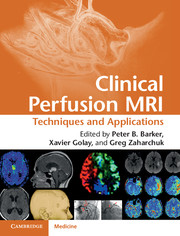Book contents
- Frontmatter
- Contents
- List of Contributors
- Foreword
- Preface
- List of Abbreviations
- Section 1 Techniques
- Section 2 Clinical applications
- 8 MR perfusion imaging in neurovascular disease
- 9 MR perfusion imaging in neurodegenerative disease
- 10 MR perfusion imaging in clinical neuroradiology
- 11 MR perfusion imaging in oncology: neuro applications
- 12 MR perfusion imaging in oncology: applications outside the brain
- 13 MR perfusion imaging in breast cancer
- 14 MR perfusion imaging in the body: kidney, liver, and lung
- 15 MR perfusion imaging in cardiac diseases
- 16 MR perfusion imaging in pediatrics
- Index
- References
9 - MR perfusion imaging in neurodegenerative disease
from Section 2 - Clinical applications
Published online by Cambridge University Press: 05 May 2013
- Frontmatter
- Contents
- List of Contributors
- Foreword
- Preface
- List of Abbreviations
- Section 1 Techniques
- Section 2 Clinical applications
- 8 MR perfusion imaging in neurovascular disease
- 9 MR perfusion imaging in neurodegenerative disease
- 10 MR perfusion imaging in clinical neuroradiology
- 11 MR perfusion imaging in oncology: neuro applications
- 12 MR perfusion imaging in oncology: applications outside the brain
- 13 MR perfusion imaging in breast cancer
- 14 MR perfusion imaging in the body: kidney, liver, and lung
- 15 MR perfusion imaging in cardiac diseases
- 16 MR perfusion imaging in pediatrics
- Index
- References
Summary
Introduction
Neurodegenerative diseases, such as Alzheimer's disease (AD), frontotemporal lobar degeneration (FTLD), Lewy body dementia (DLB), and other forms of dementia, are characterized pathologically by slowly progressive dysfunction and loss of neurons. The risk for neurodegenerative diseases usually increases dramatically with advancing age, although familial variants of these conditions exist but occur at much lower frequency than the sporadic versions. Many of these diseases also share a common neuropathology associated with the malicious accumulation of misfolded protein aggregates in the brain [1]. On structural brain MRI, however, most neurodegenerative diseases do not show characteristic lesions that are readily identifiable by a radiologist's eye. Accordingly, the diagnostic value of structural MRI for neurodegenerative diseases has been limited (except to rule out the presence of other brain pathologies, such as tumors and stroke). Aside from brain structure, the importance of perfusion to maintain brain viability is well documented [2] and there is substantial evidence for alterations of brain perfusion in neurodegenerative diseases from radioactive labeled tracer studies using positron emission tomography (PET) or single-photon computed emission tomography (SPECT) [3]. There is also broad agreement that functional alterations in the brain generally precede neuronal/synaptic loss. Accordingly, perfusion imaging in general holds great promise for detecting neurodegeneration at an early stage, before advanced neuronal loss. Perfusion imaging should also be useful for the assessment of potentially disease-modifying treatments. Finally, by mapping brain perfusion researchers hope to learn more about the physiological and functional underpinnings of neurodegenerative diseases, thereby uncovering the biometric fingerprints of these devastating conditions.
- Type
- Chapter
- Information
- Clinical Perfusion MRITechniques and Applications, pp. 164 - 178Publisher: Cambridge University PressPrint publication year: 2013



